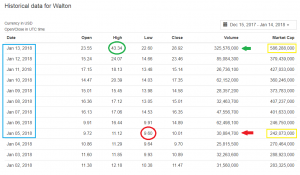
How Waltonchain (WTC) Plans To Change The Asian Tailoring Industry

Waltonchain (WTC), voted as China’s most innovative blockchain project had a significant rise of its IoT token WTC this week creating a +242% uphill starting from January 4th ending in 13th of the same month, where the price of each unit dropped below $30usd/WTC compared to ~$43usd/WTC at its “all-time highs” according to CoinMarketCap.
On January 14th, we saw an all-day struggle from Walton trying to keep its price above $25usd/WTC. The supports being persistent are trying hard to make it clear that this is now the lowest point you can enter the project.
Walton (WTC) although not a new-gamer was a ‘behind-the-scenes-token’ for a long period of time since its creation. Waltonchain system and wallet development were completed in October 2017, and Alpha testing was finished in November of the same year where people could participate in the beta before the official launch.

In the beginning, we all thought it’s just another IoT applications blockchain platform that would try to compete with the tremendously well established in the West IOTA, but as time passed, more and more Walton announcements were coming to the light, attracting both us and the community who soon started to jump into it in order to catch the upcoming set of tides.
So what exactly is Walton and why the hype?
The founding father Xu Fangcheng is also behind a men’s apparel company called “Fujian Septwolves Industry”, which is now worth ~$7.3 billion.
Don’t be mistaken, you may think that China and tailoring is not a wise combo, but if you take companies like Xiaomi, JD, Alibaba as an example in the retail world you can do the math and realize that China is not what its used to be a couple decades ago. Emerging cities like Shenzhen are growing rapidly out of rice farms in a matter of years. Cutting-edge technology, including fintech solutions like blockchain, is more than welcome in China and in fact, a big portion of the leading tech worldwide is made in China.
Knowing that Chinese are wise enough to use the intel gathered by worldwide industrial titans, based on their needs, speculations, and demands, policies and methods of appliance of technology they started long time ago coming up with their own versions of ideas that are now inarguably the most innovative when it comes to “cutting-edge”.
Walton establishes partnerships with Major Chinese tailoring brands like LALABOBO, Kaltendin, and the Shenzhen based Tanyu to create a blockchain based infrastructure between next-generation Chinese and Korean clothing brands. The company in an official statement posits that Walton Chain (WTC) team started the design, development, and testing of the major structure of the parent chain system.

“Up to now, two R&D teams have been formed in Shenzhen and Nanjing with members including blockchain technology experts, software engineers, and network engineers. The development and testing tasks have been proceeding smoothly, with the followings accomplished in August:
1) With reference to blockchain 2.0 techniques such as Ethereum, the design and the preliminary implementation of a peer-to-peer network and a distributed ledger architecture have been completed as the Walton Chain backbone.
2) Based on the mainstream of the blockchain consensus mechanisms, our featured PoS + PoW hybrid consensus mechanism is finalized with unique characteristics facilitating further application scenarios as affiliated chains based on Walton Chain.
3) A series of hash algorithms have been tested and evaluated for the purpose of data consistency verification and peer proof of work. The hash functions and calling sequence to be adopted by Walton Chain were also determined.

In October, we plan to accomplish the R&D major tasks and deploy the Walton chain infrastructure as a parent chain for applications. The Genesis block will be generated to create and distribute initial Walton Chain tokens. We will officially kick off the evolution of Walton Chain ecosystem, based on the integration of Internet of Things and RFID technology, and promote the entire project into the whole-scenario application stage of industry development and sub-chain customization.”
Then again, in the official report regarding the progress of the projects during November-December 2017, Walton states:
“In order to ensure the project application, Waltonchain R&D team conducted an in-depth market research and analysis and has completed the overall plan of chip design, as well as the prototype demo of blockchain+RFID application system based on actual RFID chip technology. The chip combines RFID tag chip and reader chip, which could be adapted for blockchain technology application. The chips are characterized by the integration of elliptic curve and decryption acceleration module, as well as a communication interface protocol for blockchain technology applications.”
The implementation of the project will promote the application of blockchain technology in the Internet of Things and solve the following problems:
1.1 Each tag is only responsible for signature verification, which would not store node data.
1.2 Tags will automatically generate random public and private keys, in order to realize Internet of Things application’s security and to prove the uniqueness of tag, the record could not be forged and tampered.
1.3 Reduce the volume of data storage and solve the blockchain data overload problem in the Internet of Things applications.
1.4 Solve the problem of slow encryption and decryption in asymmetric encryption technology.
1.5 Realize the decentralization in property and asset management, and the record is tampered-resistant.
The innovated RFID tag chip has integrated the asymmetric encryption function for adapting blockchain technology application, with excellent anti-interference and sensitivity. Its power design can meet the current strict requirements for power consumption, and the on-chip antenna and antenna matching technology have been significantly enhanced to improve the performance. Waltonchain R&D team has currently completed the chip scheme design, its coding and working on the simulation verification.
In order to realize the rapid development of Waltonchain business in Korea and company globalization, on Jan. 10, Waltonchain team reached an agreement on deep cooperation with Coinnest and will make a strategic investment in Coinnest. Both parties indicated they will develop blockchain-related technologies together to promote the development of blockchain industry as well as Waltonchain business in Korea.
Coinnest, one of the largest Korean exchanges, has reached a total transaction amount of KRW 7.5 trillion and gained 500,000 members in less than a year after its listing. The cooperation with Coinnest is an essential strategic step for Waltonchain on its way to establish a global commercial ecosystem. Waltonchain has been listed on the Coinnest Trading Platform since Dec. 2017 and has achieved recognition and support from the majority of users.
At the moment, Coinnest is not only an important exchange, but also a long-term partner in Korean market for application of multiple subchains developed by Waltonchain. It will help Waltonchain to realize commercial applications and broaden our resource base in South Korea, indeed.
In the future, Waltonchain will work together with Coinnest to support the excellent global blockchain technologies and projects and broaden the new commercial ecosystem of Waltonchain.
So, does all that sound like an attempt to compete with IOTA? We don’t think so. The closest match that comes to mind would be VeChain (VEN) at the moment who have already established links between Luis Vuitton and their platform regarding a similar blockchain based tag technology.
Walton, having partners like Sungkyun Technologies is on a quest to unite Chinese and Korean tailoring brands on a modern fintech based platform, as it should be. The last time we saw something like this was when Amancio Ortega created Inditex (the mother company behind Zara, Pull&Bear, Bershka, Massimo Dutti, among others).

Technically Waltonchain token (WTC) total supply is not more than 70,000,000 WTC with 24,898,178 WTC as a current supply. That is slightly less than Ethereum’s total supply, meaning that we could see a higher price per unit when Walton reaches Ethereum’s current market cap.
Finally, the Walton team also includes Jie Xiji (Chief Scientist), former Vice President of Samsung, and Wei Jiesong, a blockchain engineer with who previously worked for Google and Qualcomm.
Could Walton change dramatically the Asian Tailoring Industry using Fintech? Let us know your thoughts in the comments.
Reporting for The Independent Republic, Ross Peili